Armed Forces of the Republic of Kazakhstan
The Armed Forces of the Republic of Kazakhstan (Kazakh: Қазақстанның Қарулы күштері, Qazaqstannyń qarýly kúshteri) is the unified armed forces of Kazakhstan. It consists of the Ground Forces, Air and Air Defence Forces, Naval Forces, and National Guard. The national defence policy aims are based on the Constitution of Kazakhstan. They guarantee the preservation of the independence and sovereignty of the state and the integrity of its land area, territorial waters and airspace and its constitutional order. The armed forces of Kazakhstan act under the authority of the Kazakhstan Ministry of Defence.
| Armed Forces of the Republic of Kazakhstan | |
|---|---|
| Қазақстан Республикасының Қарулы Күштері (Kazakh) Qazaqstan Respýblıkasynyń qarýly kúshteri Вооруженные силы Республики Казахстан (Russian) | |
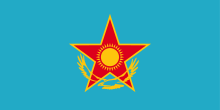 Kazakhstan Armed Forces Flag | |
 Coat of Arms of the Kazakh Armed Forces | |
| Motto | "Сильная Армия - сильный Казахстан!" (Strong Army - Strong Kazakhstan!)[1] |
| Founded | May 7, 1992 |
| Service branches | Service branches ∟ ∟ ∟ Independent formations ∟ Kazakh Airmobile Forces ∟ Special Forces |
| Headquarters | Ministry of Defence Building, Dostyk Street, Nur-Sultan Almaty |
| Leadership | |
| Commander-in-chief | |
| Minister of Defence | |
| Chief of the General Staff | |
| Manpower | |
| Military age | 18–27 years old; |
| Conscription | One year |
| Active personnel | 108,740 (2019) (ranked 45) |
| Reserve personnel | 132,000 (2019) |
| Expenditures | |
| Budget | $4,000,000,000 [2] |
| Percent of GDP | 1.1% (2018 est.)[2] |
| Industry | |
| Domestic suppliers | JSC National Company Kazakhstan Engineering |
| Foreign suppliers | |
| Related articles | |
| History | Civil war in Tajikistan Iraq War |
| Ranks | Military ranks of Kazakhstan |
The Military Balance 2013 reported the armed forces' strength as; Army, 20,000, Navy, 3,000, Air Force, 12,000, and MoD, 4,000. It also reported 31,000 paramilitary personnel.[4]
General composition
The branches and subordinate bodies of the armed forces include:[5]
- Ministry of Defense
- Branches
- Ground Forces
- Air Defense Forces
- Kazakh Naval Forces
- Airborne Forces
- Special Forces
- Rocket and Artillery Forces
- Territorial Troops
- Affiliated forces
History

On May 7, 1992, the President of Kazakhstan took a number of actions regarding defence. He signed a decree on the 'establishment of the Armed Forces of the Republic of Kazakhstan', the transformation of the State Committee of Defence of the Republic of Kazakhstan into the Ministry of Defence, on the attribution of Sagadat Nurmagambetov the military rank of Colonel General, and the appointment of General-Colonel Sagadat Nurmagambetov as Defence Minister of Kazakhstan. Mukhtar Altynbayev served as the Minister of Defence twice, most recently from December 2001 to 10 January 2007.
On June 30, 1992, the Soviet Armed Forces' Turkestan Military District disbanded, following the collapse of the Soviet Union. The most powerful grouping of forces from the Turkestan Military District then became the core of Kazakhstan's new military. Kazakhstan acquired all the units of the 40th Army (the former 32nd Army) and part of the 17th Army Corps, including 6 land force divisions, storage bases, the 14th and 35th air-landing brigades, 2 rocket brigades, 2 artillery regiments and a large amount of equipment which had been withdrawn from over the Urals after the signing of the Treaty on Conventional Armed Forces in Europe.
On July 6, 2000, a Presidential Decree "On the structure of the Armed Forces of the Republic of Kazakhstan" changed the structure: The Armed Forces returned to a dual structure (general-purpose forces and air defense forces). The Airmobile Forces were created, the transition to the new military-territorial structure, established military districts, harmonized structure and deployment of troops. On August 7, Lieutenant-General A. B. Dzharbulov was appointed commander of the Southern Military District and Lieutenant-General E. Ertaev became commander of the Eastern Military District.
In February 2001 a Presidential Decree divided the functions of the Ministry of Defence and General Staff. According to the decree, the head of the General Staff subordinates all kinds of aircraft and type of troops and military districts, while the Minister of Defence has a mostly administrative and political functions. On March 30, Major General M. K. Sihimov was appointed commander of the Western Military Region. On October 12, M. Saparov was appointed to Chief of the General Staff and First Deputy of the Defence Minister. V. B. Elamanov became commander of the Airmobile Forces. On December 8, a new Defense Minister was appointed: General K. Altynbayev, and on December 27, Major General K. K. Akhmadiev was appointed commander of the Air Defense Forces.
Key defense posts announced early in 2002 included; Major-General Tasbulatov appointed Deputy of the Defense Minister, Maj. Gen. Elamanov commander of the Southern Military District, Maj. Gen. N. А. Dzhulamanov commander of the Eastern Military District, Maj. Gen. Zhasuzakov commander of the Airmobile Forces, Major-General A. Shatskov commander of the Central Military District and K. Altynbayev given the title of Army General.
Kazakhstan had its first military parade in its history at Otar Military Base on May 7, 2013, celebrating the Defender of the Fatherland Day as the national holiday for the first time ever. During the ceremony, the first woman was promoted to the rank of General.[6]
Today there are four regional commands: Regional Command Astana, Regional Command South at Taraz, Regional Command East at Semipalatinsk, Regional Command West at Aktobe, as well as the Air Defence Forces, the Airmobile Forces with four brigades, and the Artillery and Missile Forces (formed as a separate branch on 7 May 2003).[7]
Kazakhstan is a founding member of CSTO and SCO. Kazakhstan also has an Individual Partnership Action Plan with NATO[8] & strategic cooperation with the Turkish Armed Forces.[9]
Ground Forces
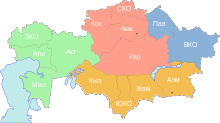
The 32nd Army had been serving in Kazakhstan for many years. The 32nd Army had been redesignated initially the 1st Army Corps (1988), then the 40th Army (June 1991). It came under Kazakh control in May 1992. On November 1, 1992, on the basis of units of the former Soviet 40th Army of the Turkestan Military District, the First Army Corps was created, with its headquarters in Semipalatinsk.[10] Later, at its base was established the Eastern Military District, retitled on 13 November 2003 as Regional Command East.
Immediately prior to its dissolution, the 40th Army consisted of the 78th Tank Division (Ayaguz); the 5202nd Base for Storage of Weapons and Equipment at Semipalatinsk (prior to 1989 – the 71st Motor Rifle Division); the 5203rd BKhVT Ust-Kamenogorsk (prior to 1989, the 155th Motor Rifle Division); the 5204th BKhVT at Karaganda (prior to 1989 – the 203rd Zaporozhye Khingan Motor Rifle Division), taken over by Kazakhstan on 7 May 1992, the 69th Tank Division (mobilisation) (Ust-Kamenogorsk), and the 10th Fortified Area.[11] The 69th Tank Division and the 10th Fortified Area were both disbanded in 1992.
In the middle of the 1990s Kazakhstan's land forces included the 1st Army Corps (HQ Semipalatinsk), with the 68th Motor Rifle Division (Sary-Ozek, in Kyzylorda Province) – 2 motor-rifle and one tank regiment and the 78th Tank Division (Ayaguz).[12] While the 68th Division was called a motor-rifle formation, in equipment terms it had almost 300 tanks and about 500 armoured fighting vehicles. The 78th Tank Division had 350 tanks, 290 armoured fighting vehicles and 150 artillery pieces. The 210th Guards Training Center, the former 80th Guards Motor Rifle training Division, had 6,000 soldier and officers and 220 tanks and 220 artillery pieces, so was a strengthened division. It was often called the Division of Guards by Kazakh sources.
Some of Kazakhstan's officers have trained at the United States Military Academy at West Point.
Today the Ground Forces include four regional commands:[13]
- Regional Command "Astana" (Headquarters Karaganda) – the administrative boundaries of Akmola, Karagandy Province, Kostanay Province and North Kazakhstan. The command acts as the Supreme Commander's reserve. The commander of the district is Major General Vladimir Shatsky (as of April 2008). The District includes the 7th Separate Motor Rifle Brigade at Karaganda.
- Regional Command "East" (Headquarters Semipalatinsk) – in the administrative boundaries of East Kazakhstan and Pavlodar Province (Families, Ust-Kamenogorsk, George, and Ayagoz Usharalsky garrisons). Commander of the district is Lieutenant General Nikolai Pospelov (as of September 2008). The District has the 3rd Mechanized Division (formerly the 78th Tank Division) at Ayaguz, three (?) bases for storage of military equipment, 3rd Separate Motor Rifle Brigade at Usharal (Military Unit No.40398, formed on the basis of a motor rifle regiment of the 155th Motor Rifle Division), 4th Separate Motor Rifle Brigade at Novo-Akhmirovo, Ust-Kamenogorsk (Military Unit No.27943), a cannon artillery brigade, and an air defence missile brigade.
- Regional Command "West", (Headquarters Atyrau) – in the administrative boundaries of the West Kazakhstan Province, Aktobe Province, Atyrau Province and Mangystau Province. The main task is ensuring the integrity of state borders, territorial integrity, sovereignty and economic interests of Kazakhstan in the Kazakh sector of the Caspian Sea. In 2008, the commander of the district appointed general Alimzhan Kanagatovich Erniyazov. The District has separate motor rifle and artillery brigades.
- Regional Command "South", (Headquarters Taraz) – in the administrative boundaries of Almaty Province, Zhambyl Province, South Kazakhstan Province and Kyzylorda Province. The district's main task is ensuring security in the south-eastern borders of the country. In 2008, General Alikhan Brimzhanovich Dzharbulov was appointed commander of the district. The District includes the 4th Motor Rifle Division at Sary-Ozek in Almaty Province, the 5th Separate Motor Rifle Brigade (Taraz, Military Unit No.85395, 1,500 personnel), the 6th Separate Motor Rifle Brigade (Shymkent, Military Unit No.35748, with five motor rifle and tank battalions, two artillery battalions), a mountain battalion, and the 210th Training Center. The 206th Reserve Division was previously stationed in this command area.
There are also the Air Defence Forces, the Airmobile Forces with four brigades, and the Artillery and Missile Forces (formed as a separate branch on 7 May 2003).[7]
Ground forces equipment

| Name | Origin | Type | In service | Notes |
|---|---|---|---|---|
| Armored fighting vehicle | ||||
| T-72BA | Russia | Main battle tank | 300[14] | |
| BMPT | Soviet Union | Tank Destroyer | 3[3] | |
| BTR-80 | Soviet Union | Amphibious APC | 110[3] | of which 44 are the 82A variant |
| BPM-97 | Russia | APC, MRAP | 18[3] | |
| Otokar Cobra | Turkey | Infantry mobility vehicle | 17+[3] | Manufactured locally with license[15] |
| Marauder | South Africa | APC | 90[3] | |
| Humvee | United States | Armored car | 40[3] | |
Airmobile forces
The Airmobile Forces were formed by grouping the 35th Guards Air Assault Brigade with new brigades formed from previous Soviet units. The 35th Guards Air Assault Brigade arrived from Germany in April 1991, and was taken over by Kazakhstan in 1992. Near Karaganda was the 5204th Base for Storage of Weapons and Equipment, the remnants of a motor rifle division.[16] In 1998 two motorized rifle brigades were created from the former storage base. One of which was left near Karaganda, and another called 2nd Separate Motor Rifle Brigade and was relocated 200 kilometers to the north of Nur-Sultan, which by that time was the capital, and for that reason ought to have a decent court garrison. No units were stationed in Nur-Sultan (Astana) during the Soviet period. In October 2003, the 36th Separate Air Assault Brigade was formed on the basis of the 2nd Motor Rifle Brigade. On the basis of Taldykorgan Motor Rifle Regiment, 173rd Sary Ozekskoy Motor Rifle Division, in April 2003 was formed the 37th Separate Air Assault Brigade.
- the 35th Guards Air Assault Brigade at Kapshagai,
- the 36th Air Assault Brigade at Nur-Sultan,
- the 37th Air Assault Brigade at Taldykorgan
- the 38th Air Assault Brigade – Peacekeeping Brigade KAZBRIG at Almaty[13][17][18]
Air and air defence forces
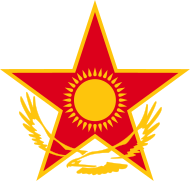

At the time of the dissolution of the Soviet Union, the 24th Fighter-Bomber Aviation Division with three aviation regiments and three separate regiments was stationed in Kazakhstan.[19] By late 1993 the Kazakhstan Air Force comprised a total of six regiments, with a further air defence fighter regiment. The 11th Division included the 129th Fighter-Bomber Regiment based at Taldy Kurgan, with MiG-27 'Flogger' aircraft and the 134th Fighter-Bomber Regiment at Zhangiz-tobe with MiG-27s. There was also the 149th Bomber Regiment at Zhetigen/Nikolayevka, with Sukhoi Su-24 'Fencers'. Independent elements comprised the 715th Fighter Regiment at Lugovaya, with MiG-29s and MiG-23 'Floggers'; the 39th Reconnaissance Regiment at Balkhash, with MiG-25RBs and Su-24MR 'Fencer' aircraft, and the 486th Helicopter Regiment based at Ucharal with Mi-24 'Hind'. The sole air defence fighter aviation regiment was the 356th Fighter Aviation Regiment at Semipalatinsk with MiG-31 air defence fighters. The Air Force was under the command of Major General Aliy Petrovich Volkov.
Air Force 12,000 (incl Air Defence) 1 air force division. Pilots fly approximately 100 hours per year.
Today the Kazakh Air and Air Defence Force has four fast jet bases:[20]
- 600th Guards Air Base, Zhetigen, Nikolayevka, Almaty, with MiG-29,
- 602nd Air Base, Chimkent, with MiG-29,
- 604th Air Base, Taldykorgan Airport, with MiG-27 and Su-27 (previously the 129th Fighter-Bomber Regiment)
- 610th Air Base, Sary-Arka Airport, Karaganda, with MiG-31.
Aircraft
Current inventory
.jpg)
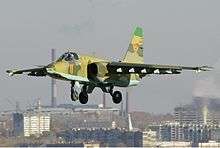
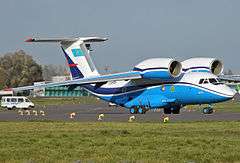
| Aircraft | Origin | Type | Variant | In service | Notes | ||
|---|---|---|---|---|---|---|---|
| Combat Aircraft | |||||||
| MiG-29 | Soviet Union | multirole aircraft | 12[21] | ||||
| MiG-31 | Soviet Union | Interceptor aircraft | 21[21] | ||||
| Sukhoi Su-25 | Soviet Union | CAS | 14[21] | ||||
| Sukhoi Su-27/Su-30 | Soviet Union | Air Superiority/Multi Role Fighter | Su-27/Su-27BM2 and Su-27UB/Su-27UBM2/Su-30SM | 27[21] | 24 Su-27 and 16 Su-30 on order[21] | ||
| Transport | |||||||
| Antonov An-12 | Ukraine | heavy transport | 1[21] | 8[21] | |||
| Antonov An-72 | Ukraine | heavy transport | 1[21] | STOL capable aircraft | |||
| CASA C-295 | Spain | transport | C-295M | 8[21] | 1 on order[22] | ||
| Helicopters | |||||||
| Mil Mi-17 | Soviet Union | utility | Mi-8M/17 | 49[21] | |||
| UH-1 | United States | utility helicopter | UH-1H | 3[23] | |||
| Mil Mi-35 | Soviet Union | helicopter gunship | 8 on order[21] | ||||
| Mil Mi-26 | Russia | heavy lift / transport | 2[21] | ||||
| Eurocopter EC145 | Germany | utility | 12[21] | 20 on order[21] | |||
| Trainer Aircraft | |||||||
| Aero L-39 | Czech Republic | jet trainer | 17[24] | ||||
| Zlin 242 | Czechoslovakia | trainer aircraft | 1[21] | ||||
| unmanned aerial vehicle | |||||||
| CAIG Wing Loong | People's Republic of China | MALE UCAV | 2[25] | ||||
Future purchases
On 28 October 2010, two strategic agreements signed today establish the framework for Eurocopter's creation of a 50/50 joint venture with Kazakhstan Engineering Kazakhstan to assemble EC145 helicopters, along with the sale of 45 of these locally assembled aircraft for government missions in the country.[26] On 28 November 2011, Eurocopter delivered the first of six EC145s ordered to date by the Kazakh Ministries of Defence and Emergencies.[27] Deliveries are to continue through 2017.
On 3 January 2012, Airbus Military signed a firm contract with Kazspetsexport, a state company belonging to the Ministry of Defence of Kazakhstan, to supply two EADS CASA C-295 military transport aircraft plus the related service support package for spare parts and ground support equipment. Additionally, a Memorandum of Understanding (MOU) has been signed for a further six C295 aircraft, for which separate firm contracts will be signed progressively over the next few years. The first two aircraft will be delivered by April 2013 and for the remaining six aircraft a delivery schedule will be defined over the following years. This purchase likely represents a quid pro quo. In 2008, EADS made titanium sourcing agreements with Kazakh suppliers.[28]
In May 2012, Kazakhstan signed a letter of intent to acquire 20 Eurocopter EC725 helicopters. They were to be assembled in Nur-Sultan by Kazakhstan Engineering.[29] These Eurocoptors will be fitted with modern systems made by the Turkish firm Aselsan.
Naval Forces

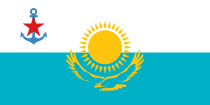
Kazakhstan's Naval Forces were established by presidential decree on 7 May 2003 in spite of being the largest landlocked country on earth. They operate on the Caspian Sea, based at Aktau. The Kazakh Naval Force has a strength of 3,000 personnel and is equipped with fourteen inshore patrol craft.[30]
Equipment
| Vessel | Origin | Type | In service | Notes |
|---|---|---|---|---|
| Kazakhstan | Kazakhstan | Missile boat | 4[31][32] | Kazakhstan class |
| Türk | Turkey | patrol boat | 2[33] | |
| OPV-62 | Israel | patrol boat | 2[33] | Pacific-class |
| Shaldag | Israel | Go-fast boat | 6[33] | Assembled in Azerbaijan |
| 10750E harbor minesweepers | Russia | minesweepers | 2 | The first vessel was commissioned in 2017[34][35] |
| Project 01340G | Russia | Research vessel | 1 | The ship is known to be a Hydrographic ship. the vessels name is Zhaiyk[36][37] |
The naval aviation base in Aktau was opened eight years later, in 2011. The 612th Airbase in Aktau will provide the home for two Su-27 fighter jets, seven Su-27 pilots and twelve helicopter gunship pilots, according to a report in Interfax-Kazakhstan (not online, via BBC Monitoring). The report doesn't specify the model or number of helicopters, but it is presumed they are Mi-24s.[38]
Security agencies and commando units
There are a number of special forces units reporting to various Kazakh security agencies which are not part of the Armed Forces. Examples of this include an Arystan Commando Unit and a Border Guard of the National Security Committee of the Republic of Kazakhstan (KNS), the Police have units, and the Kazakh Presidency.
Additionally, a small Republican Guard exists, with 2,500 soldiers (1994), but this force is not considered as a part of the Army. The Republican Guard was established on March 6, 1992, when the President of Kazakhstan signed a decree on their creation. The Republican Guard was established on the basis of a separate brigade of operational designation of the Internal Troops deployed in the village of Kaskelen district of Almaty region.[39] Two Republican Guard regiments were created, stationed in Nur-Sultan and Almaty.
Women in the Military
There are approximately 8,000-8,500 women serving in the Kazakh army.[40] Of those women, 750 are officers.[41] The Ministry of Defence has been working to promote women in the military through educational programs and career advancement opportunities. Only 2.1% of leadership positions within the Ministry of Defence are held by women.[42] The Ministry of Defence also hosts Batyr Arular, which is a nationwide competition for service men and women, showcasing their combat skills, combat readiness and overall physical ability. Batyr Arular gives awards for the best service women.[43]
Higher educational institutions
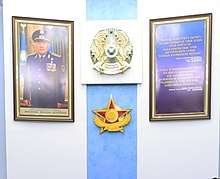
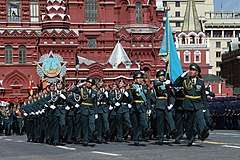
The following institutions are the main military academies in Kazakhstan:
- National Defense University
- Talgat Bigeldinov Military Institute of the Air Defence Forces
- Military Institute of the Kazakh Ground Forces
- Military Engineering Institute of Radio Electronics and Communications
Aktau Naval Academy
The Aktau Naval Academy of the Ministry of Defense of Kazakhstan was the main educational institution of the Kazakh Naval Forces. It established in March 2001 by order of the national government on the basis of the Vocational Technical School No. 2. which preceded it. It was reorganized into a naval institute on July 10, 2003, effectively upgrading its status as a nationally recognized military school. Graduates of the institute have served in ships and coastal units of the Navy and maritime units of the Border Service of the National Security Committee of the Republic of Kazakhstan. In 2011, the institute was deactivated and liquidated.[44]
Academy of the Border Service of the National Security Committee
The Academy of the Border Service of the National Security Committee (Kazakh: Ұлттық қауіпсіздік әскери институты, Russian: Академия Пограничной службы КНБ) was founded on December 26, 1931 and was renamed April 1938 to the school Kharkov Military School of the Border and Internal Troops of the NKVD. On April 2, 1957, the institution was transferred from the authority of the Interior Ministry to the KGB. In July 1960, the school was transformed into a four year school which would be known as the Alma-Ata Higher Frontier Command School. In 1993, at the base of the newly formed border troops, the Military Institute of the National Security Committee of Kazakhstan was established and introduced a higher legal education program for graduates, which would continue until 1997. The next 20 years would be marred with name changes until it was given its current name in March 2012.[45]
Cadet schools
- Astana Zhas Ulan Republican School
- Almaty Zhas Ulan Republican School
- Shymkent Zhas Ulan Republican School
- Karaganda Zhas Ulan Republican School
References
- https://tengrinews.kz/kazakhstan_news/v-kazahstane-sostoyalsya-pervyiy-boevoy-parad-233706/amp
- "SIPRI Publications". Archived from the original on 2010-03-28.
- Trade Registers. Armstrade.sipri.org. Retrieved on 2017-12-18.
- IISS 2013, 221.
- Закон № 29 от 7 января 2005 года Республики Казахстан «Об обороне и Вооружённых Силах Республики Казахстан»
- "First Military Parade in Kazakhstan". The Gazette of Central Asia. Satrapia. 7 May 2013.
- Marketos, Thrassy N. (2008-11-21). China's Energy Geopolitics: The Shanghai Cooperation Organization and Central Asia. Routledge. ISBN 9781134106028.
- "Kazakhstan and Turkey expand cooperation on defense". The Republic of Kazakhstan Ministry of Foreign Affairs. October 1, 2014. Archived from the original on February 4, 2020.
- For early information on Kazakhstan's land forces, see also 'Kazakhstan's Defence Profile Revealed,' Jane's Defence Weekly, 9 October 1993
- Michael Holm, 32nd Combined Arms Army, 2015.
- Machine translated and cleaned up from a Russian source at http://www.nomad.su/?a=2-200205081022, 'Military-political safety of Kazakhstan'
- Most specific unit information, including military unit numbers, locations, etc. is sourced from Vad777, Kazakh Ground Forces Archived March 24, 2012, at the Wayback Machine, accessed February 2010
- International Institute for Strategic Studies (IISS) (9 February 2016). "The Military Balance 2016". The Military Balance. 116: 185–186. doi:10.1080/04597222.2016.1127558.
- History of the Airmobile Forces of Kazakhstan, http://desantura.ru/articles/23/?PAGEN_1=2
- Archived March 31, 2012, at the Wayback Machine
- Michael Holm, 24th Fighter-Bomber Aviation Division, accessed October 2011. Note division was given as the 11th in Kazakhstan AF Restructures, Jane's Defence Weekly, 25 September 1993
- Vad777, Brinkster.net, July 2010
- "World Air Forces 2020". Flight Global. Retrieved 2020-02-12.
- Hoyle2019-03-21T14:57:59+00:00, Craig. "C295 purchase to bolster Kazakhstan defences". Flight Global. Retrieved 2020-02-12.
- "Kazakhstan Air Force takes delivery UH-1 Huey helicopter from the United States". Defence Blog. 2016-04-09. Retrieved 2020-02-12.
- "World Air Forces 2018". Flightglobal Insight. 2018. Retrieved 14 January 2018.
- "Kazakhstan purchases two Chinese Wing-Loong UCAVs | IHS Jane's 360". 2016-06-08. Archived from the original on 2016-06-08. Retrieved 2020-02-12.
- "HeliHub Kazakhstan buys 45 EC145s and signs production JV with Eurocopter". Retrieved 14 December 2014.
- "HeliHub First of six EC145s deliverd to Kazakhstan". Retrieved 14 December 2014.
- Defense Industry Daily, EADS-Signs-its-Own-Titanium-Deal-with-Kazakhstan
- "Airbus Group". airbusgroup. Archived from the original on 30 July 2012. Retrieved 8 October 2015.
- "Military Balance in Europe 2011"., March 07, 2011
- "Министерство обороны Республики Казахстан (МО РК)". mod.gov.kz. Retrieved 8 October 2015.
- "Kazakhstan Navy Unveils Its First Ship". EurasiaNet.org. Retrieved 14 December 2014.
- Trade Registers. Armstrade.sipri.org. Retrieved on 29 May 2015
- "Archived copy". Archived from the original on 2018-03-17. Retrieved 2018-03-17.CS1 maint: archived copy as title (link)
- "Kazakhstan to buy two mine 'hunters' from Russia". Tengrinews.kz. 15 July 2013. Retrieved 1 April 2019.
- Pike, John. "Kazakhstan Navy". www.globalsecurity.org.
- "Kazakh naval vessels participate in 2017 Sea Cup in Azerbaijan - The Astana Times". 8 August 2017.
- "Military Balance in Asia 2011"., March 07, 2011, page 55-56
- "Сегодня – День создания Республиканской гвардии". Retrieved 14 December 2014.
- "8,000 women serve in the Kazakh army".
- "Kazakh army women balance gender and responsibilities".
- https://gender.stat.gov.kz. Missing or empty
|title=(help) - "Batyr Arular competition announces best servicewomen of 2016".
- "Военно-морской институт (Актау), специальности". edu.Resurs.kz. Retrieved 1 April 2019.
- "U1200000282.20120313.rus". ru.government.kz. Archived from the original on 21 March 2019. Retrieved 1 April 2019.
- CIA World Factbook, 2003 edition.
- Abai TASBULATOV, "The Kazakhstani Republican Guard: Its Record and Development Prospects", Military Thought, No. 4, 2009, pages 136–142
External links
- Journal of Power Institutions in Post-Soviet Societies, Issue 11, 2010, Security and Defense Reform in Post Soviet Central Asia
- Building National Armies – Kazakhstan
- Kazakh armored forces parade
.jpg)
